Night Streets was a great comic from Arrow Comics (later Caliber Press) created by Mark Bloodworth (also known for Deadworld, Cheerleaders from Hell). Featuring an ensemble cast before ensemble casts in comics became a thing + black and white with a feel like Sin City (yet released years before Sin City). Night Streets featured a female heroine (think Black Canary and Huntress), a police force that drew inspiration from TV shows (like Crime Story, Hill Street Blues, and Barney Miller rather than the GCPD) with villains like Felonious Katt (think Kingpin but as a human cat).
I was a fan of Night Streets from the start and recently I became the proud owner of several unpublished Night Streets pieces of artwork from creator Mark Bloodworth. I thought to myself, “What a good time to interview Mark about his excellent series.”
JOESEPH SIMON
How does it feel to be at the stage in being a comic book creator when people are coming up and asking about characters you created decades prior?

MARK BLOODWORTH
Well, first, I consider myself more an artist/illustrator that has done some work in the field of comics. Also, my list of creations is a very short list.
That being said, it does indeed feel rewarding to hear from a fan at a convention or on social media who has enjoyed something I worked on. Even more when they tell me it became an impetus to push them into something creative, either as a vocation or just as an outlet to stay sane.
Frankly, I find it astounding that anyone remembers something like NIGHT STREETS, let alone as many as I have heard from. If they bring up something like CHEERLEADERS FROM HELL, it’s more surprising. I even forgot about that one for quite a while.
JOESEPH
You’re known for Crime and Horror comics. Which came first for you as a reader?
MARK
I would have to say, horror. I was watching monster/horror movies and reading monster books and comics before I knew that there were superhero comics. I remember
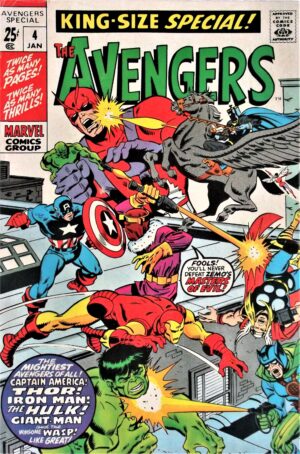
watching the Marvel Superheroes TV show but never saw a comic until I was about 7 or 8 years old. It was a coverless copy of King-Size Avengers #4 found at a yard sale. The two stories reprinted in that had been adapted for the TV show and I instantly recognized them. Then it all exploded as far as a love of comics as an artistic outlet. But before that, it was first-run and early reprints of Jack Kirby and Steve Ditko monster comics before I even knew who those two creators were.
JOESEPH
I know Hill Street Blues and St. Elsewhere inspired you to create Night Streets. I’m curious what your other influences were for Night Streets? Speaking of TV shows, the period of time that you created Night Streets was also the time when Wise Guy and Crime Story on TV. Both TV shows and your Night Streets resonated with me and now. Were they an influence?
MARK
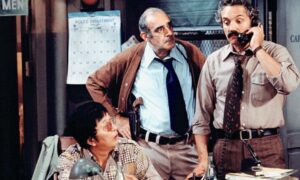
Well, as you pointed out, those two ensemble shows (HILL STREET BLUES and ST. ELSEWHERE) were very influential to me as far as how to balance storytelling with a large cast of characters. As well as a show like Barney Miller. That was another ensemble cast show where each character had a unique voice just by the scripting. That was something I wanted to accomplish as I don’t consider myself a writer in the classic sense. I really just script a scene and write dialogue.
I never watched WISEGUY – I knew of it but never got into it. CRIME STORY on the other hand sucked me in – I think it was the time period it was set in as well as the cast.
However, as far as a major influence in making my first foray into an ongoing comic book series be an ensemble cast with no real “main” character, I would have to put the blame squarely on The Hernandez Brothers’ LOVE AND ROCKETS. I was introduced to those stories in the early eighties and I loved the seamless blend of the mundane and the fantastic. The ever increasing cast of characters that all had one foot
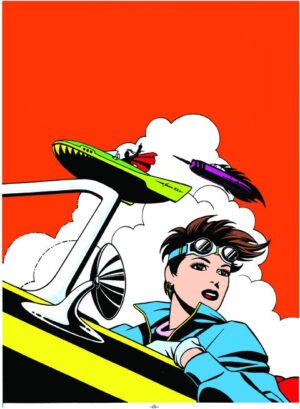
in the “real” world and one foot in some other dimension. Everything was there and everything was used genre-wise and there never seemed to be any hard divisions between the soap-opera romance of two women and the fact that one of them made a living as an engineer fixing robots and spaceships. Someone living in the city could have roots in a small country town where it was just as typical to see a deceased relative wave to you from under a shady tree as it was to watch the town sheriff have to divide her time between breaking up a fight and delivering the newest addition to the populace as the town’s midwife.
I read that series for many years and each issue was like getting a letter from an old friend. That was a feeling I wanted to generate in whatever it was that I would decide to do. So when NIGHT STREETS started to evolve in my head, that feeling was to be the overall direction of the series.
JOESEPH
Night Streets was initially published at Arrow Comics. Was this your first job in comics? How was working at Arrow?
MARK
 I had done some comics earlier on a college based title for a couple issues. A group of student’s from Detroit’s (then named) Center For Creative Studies got together to start a comic book anthology and put an ad out for like-minded creatives. I saw it and contributed.
I had done some comics earlier on a college based title for a couple issues. A group of student’s from Detroit’s (then named) Center For Creative Studies got together to start a comic book anthology and put an ad out for like-minded creatives. I saw it and contributed.
But as far as a paying gig, with global distribution, yes, Arrow was the first real job and first publishing company I worked with and for in producing comic books.
Arrow was a lot of fun. We would have weekly/bi-weekly meetings at the HQ which was the apartment that the two founders, Ralph Griffith and Stuart Kerr shared. We would all gather there on typically a Friday night (iirc) and each of us creators would open our portfolios and show what progress we had made on our respective titles. It was a way to keep each other motivated and inspired. At the height of it there would be myself, Ralph, Stu, Randy Zimmerman, Susan Van Camp, Guy Davis, Vince Locke, Tim Dzon, Mark Winfrey, Sandy Schreiber, and Jason Moore. I can’t remember if other artists like Alan Oldham or Dirk Johnston ever attended any of those meetings or not, but I do remember that sometimes Robert Knight (the creator of Felonious Katt) and his brother Marty would stop in. As well as other local creators that may have been contributing something or just wanted to hang for the evening. After business was taken care of we would start watching as many B-Movies (A-list titles sneaked in once in a while) as we could before we all passed out from too much pizza and potent potables.
JOESEPH
Arrow was part of the Black and White Explosion. I imagine the following implosion is what caused Arrow Ver. 1 to close down. How did the implosion affect your standing
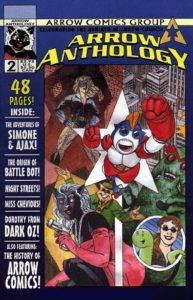
in the industry? How did you stay involved as a creator during and after the implosion?
MARK
Yes, the implosion and the resulting wasteland was what did Arrow in. Distributors went out of business owing money to a lot of companies, the smaller independents, like Arrow, felt that blowhard.
As for my personal standing in the business? The biggest effect was: I had no way to get the rest of the story out. I needed (along with the other creatives mentioned above) to find a new publisher to work with. However, they were all scrambling to pick up the pieces as well. So, an independent publisher still able to do business was most likely unable to take on an added title – even a proven one from Arrow. I wasn’t alone in this either. Guy Davis, Vince Locke, and Mark Winfrey – even though they now possessed sole creator rights to their respective titles (Guy had THE REALM, Vince had DEADWORLD and I believe Mark was given sole ownership of SYSTEM SEVEN) were still looking for someone or something that had the clout and quite frankly the trust to get the books out.
After a couple false starts and stalls with publisher(s) and looking for any kind of pencil or ink work from surviving companies, we were fortunate enough to have Gary Reed decide he wanted to not just sell comic books but publish them as well.
JOESEPH
Night Streets continued at Caliber Press. How did that occur and what came of this?
MARK
As previously stated, it was lucky for us that Gary Reed decided he wanted to publish comics as well as sell them. It was either late 1988 or early 1989 that Gary sent word out to me and the other Arrow alumni that he wanted to meet with us regarding a new venture. That was Caliber Comics. The word went out to other local creatives as well like James O’Barr, Alan Oldham, and Dirk Johnston. Then around mid-1990 (i think), Kevin Van Hook was hired as Production Manager.
Gary told me during a meeting that he would publish anything I came up with. That, whatever the story I wanted to tell, I could rest assured I had a publisher. That helped lift my spirits.
Now, I had been continuing to work on that first NIGHT STREETS story (remember, all the false starts?) so I was close to having it finished. Gary and I agreed it would be best to collect it all in two trade paperbacks taking the first four issues – plus some new stuff – and make that Book One, which was released at the beginning of 1990. Then take issue five and what would have been issues six and seven and make that Book Two, that came out in early Spring 1990.
Once that was finished – I was burnt out on it. I was scripting, penciling, and inking and just didn’t want to start another cycle of it. The stories were all there, character arcs, etc. But I just didn’t want to jump back in again. Luckily around this time, Vince was feeling the same way about DEADWORLD. So I started taking over penciling chores on DEADWORLD with issue twelve. That was an immense help, not just mentally and creatively, but in gaining new work.
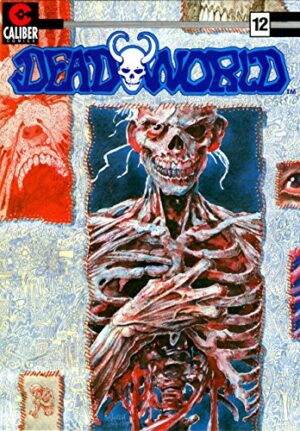
JOESEPH
You have two stories in Arrow Anthology. Tell us a little about those stories and were they released before or after the move to Caliber Press?
MARK
The Arrow Anthology was after Caliber. Those two issues were released in late 1999 or early 2000 (iirc). It was really one story told in two chapters. I just wanted to tell a story about some of the more familiar characters from NIGHT STREETS about twenty years down the line from where I left off with them.
JOESEPH
Who is Mal Brayton?
MARK
Basically, he’s what we would call today a “Mary Sue” or a “Gary Stu”. That’s pretty much it.
He’s essentially the person who is the biggest fan of the “reality” known as the world of NIGHT STREETS. He has flaws – but they are very superficial. He’s seemingly the most inept and the most vulnerable of all the adults that have an active part in the stories. Yet – had the series run its course – he would have been the one that found out enough about Katt to eventually destroy Katt’s world and sense of being.
JOESEPH
I have not been able to find the Night Streets story from Midnight Mortuary. What is that story about?
MARK
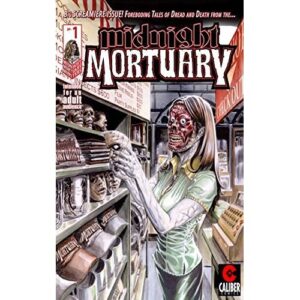
It’s a wordless, four pager involving a serial killer and it was entitled “I Remember Standing On The Corner At Midnight…”. I called it that because there was this one time I heard the song Main Street (Bob Seger), and for whatever reason, while I was listening to it, even though I had heard it countless times before, it didn’t seem like an innocent song of reverie and nostalgia. It sounded like a serial killer reliving a particular night’s kill after perhaps looking at some souvenir or even walking down a particular street. I did the layout according to the lyrics of the song. Of course, I couldn’t print the story with the lyrics, so I left it silent. But I kept the opening line of the song as the story’s title, just in case someone picked up on it, they could look up the lyrics or listen to the song as they paged through.
The only real connection it has is the front page of a newspaper which is the same fictional newspaper from NIGHT STREETS. However, something like that four pager would have been the kind of backup stories I would’ve put in an issue of NS.
JOESEPH
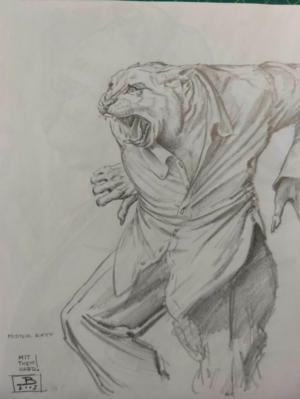
The art that I purchased is from an untold story of Night Streets. I am wildly interested in the two pages that you drew. The fight scene between Katt and Black Dehlia and the scene of Katt seemingly in retreat. If you may, when did you create these, if it was a story for a publisher, who would that publisher have been? What was the story and why didn’t it happen?
MARK
Those were concepts for a later story. Probably something that would have taken place in the late 1990s. However, the Katt and Dahlia fight would have been a story that took place in the early 2000s, if I remember my timeline.
The artwork was created in the early 2000s.
Oh, I would have taken it to Gary Reed at Caliber before even bothering to look anywhere else.
JOESEPH
In a prior interview, you mentioned you were burned out on Night Streets. I’m curious, given you had other story ideas for the series, is there a possibility of Night Streets coming back?
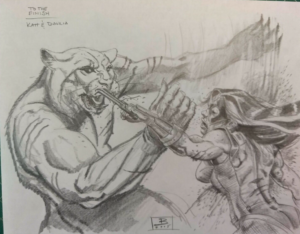
MARK
I ask with a few things in mind. Time has passed since you made that comment. There are plenty of publishers out there again. You are also no stranger to self-publishing. The idea of creators taking on properties from the past is interesting. People do change. How they create changes.
Some people say you can’t go back to the past. I say you can take the past and improve upon it. Improve upon with experience and knowledge. Improve upon it based on the person you are now and how you create has evolved.
If I win the lottery and can pay people to do the heavy lifting? Then, yes. Getting it published was never a problem. Gary Reed would have published any of it in a heartbeat. I sometimes think he wanted to read the book more than I did.
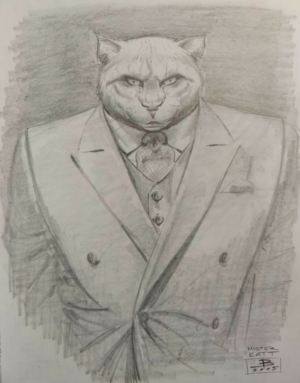
There’s too much of it in my head to ever get out. I would get ten pages in and leave it alone for ten years. No way for me alone to get it out. I tried. Would much rather take three or four creative teams and give them each an assignment and start putting it out that way. But, again, If I win the lottery and can pay people.
JOESEPH
You called Felonious Katt Night Streets version of Kingpin. Given the character development of Kingpin and his appearance at Marvel Cinema/TV, would you still say that?
MARK
Yes. Mr. Katt, as he appeared in NIGHT STREETS was definitely influenced by Frank Miller’s take on Kingpin during his initial run on Daredevil and how he was handled on the Netflix show. All I would add is that Katt would be even less sure of his motivations, outside the obvious, because unlike Fisk, Felonious Katt doesn’t even know what he is.
JOESEPH
At one point there was going to be a cross over event at Arrow. You mentioned considering giving Black Dahlia powers. Are you glad that didn’t come to pass? Or is that a direction that you, today, think still has merit?
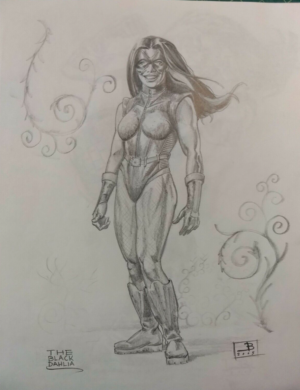
MARK
I truly can’t be glad or regretful that it didn’t happen – I mean it was soooo long ago. Quite frankly, if I wanted to, I could just write the story tomorrow. Nothing stopping that from happening other than the inclination to do so.
If the series had continued and the company-wide cross-over became more than talk, I think it probably would have still occurred (the Dahlia getting extra strength) but I would have made sure a price was paid for it. “The Bill Comes Due…” as it were.
Yes, even today, it would still be the direction to go into. Perhaps not necessary to any plot points – but still an idea to toy with. There’s no way she would have turned down the chance at getting to be one-up either in strength and/or constitution in order to keep being the vigilante she was.
JOESEPH
You were inspired by Black Canary and Huntress to create Black Dalhia. Which Earth, one or two, are you a bigger fan of?
MARK
Honestly, I could never keep them straight. Whichever was the Earth-Prime during DC’s bronze age. That would be mine. Because that’s what I grew up with.
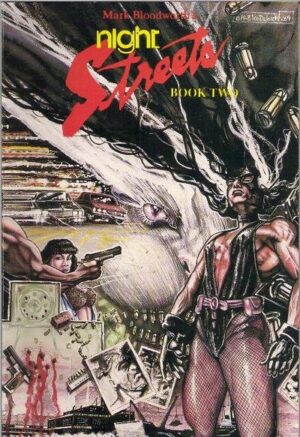
JOESEPH
I get the feeling Capt. Harrison was inspired more by a TV detective than comic book ones. Set me straight on this one.
MARK
Yeah, Capt. Harrison is an amalgam of Barney Miller and Frank Furillo but portrayed by Roy Scheider.
JOESEPH
Considering Night Streets is a work from the past, what are you most proud of with Night Streets and what are you less proud of?
MARK
Most Proud:
Getting the initial story finished, even though it took as long as it did.
Getting a fan letter from Harlan Ellison.
Least Proud:
That first issue…..yeesh. I remember hearing a comment from someone back then regarding the first issue, it was something along the line of “..I couldn’t even READ it!”. That made me kind of chuckle back then and I thought, “Well, that’s one less sale for issue two, I guess.” So fast forward about 5 years or so, and I’m digging through old back issues and find a NS #1, I open it up to look at it, start turning the pages, and I think to myself, “Jesus, what was I thinking? I can’t even READ this!”. LOL.
Also, not writing a fan letter back to Harlan Ellison.
JOESEPH
You mention the idea of getting other creators involved to make the time involved in releasing Night Streets less so as something you would have done differently. If you did
that then who would you have asked to join you? If you did that now, who would ask to join you?
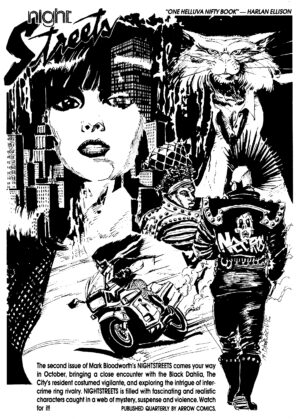
MARK
Oh, back in the late eighties, I would have asked any of the old Arrow crew first without any hesitation. Then I would have asked Steve Seagle and Stefano Gaudiano, Derek McCulloch, and Simon Tristam (anyone that worked on the book Night Life, really), and John Howard. If we’re getting into the Caliber days, James O’Barr, Mike Allred, Jason Moore, and Kevin Van Hook, and I would’ve ask Malcolm Bourne to do some writing. If they didn’t want to take on a paid story, I’d have tried to at least commission a cover or pinup.
If I win the lottery tomorrow? All the above as well as Kyle Hotz, William Skaar, and then try to coerce some people like Arvell Jones, Keith Pollard, and others that were creating characters and worlds when I was a young fan and collector. Those are just off the top of my head. I’d have to really look around again. Then make sure to line up the right stories with the right artist and/or writer-artist teams.
……………………………………………
Thank you, Mark. Night Streets was and is a very inspiring series. Your late 80’s line up and lottery forward versions of hypothetical Night Streets would be pretty interesting. I hope readers who have already read Night Streets gained new insight into this great series. And to those who have not read the series, go to your Local Comic Store or online and track down the series and read it for yourself.
For those who like Mark’s artwork, he does commissions. For more information on commissions and to keep up to date on Mark:
https://www.instagram.com/markbloodworth1963/ : : mark.bloodworth1963@gmail.com : : https://www.facebook.com/mark.bloodworth.92
